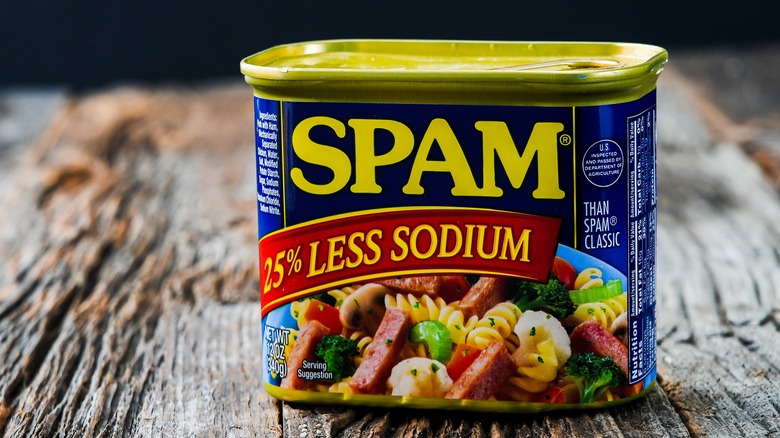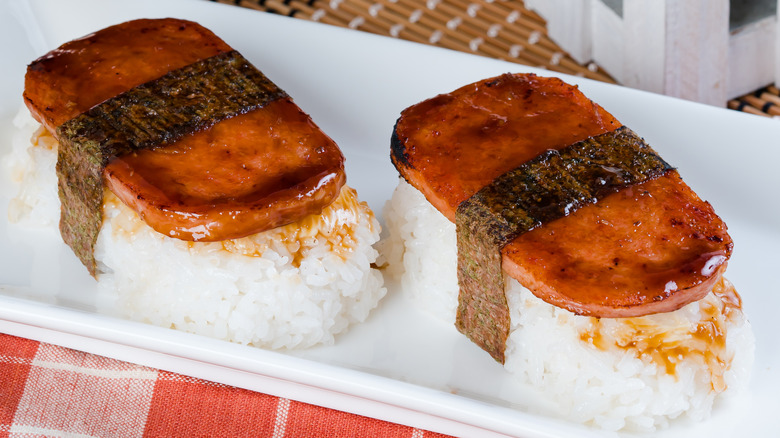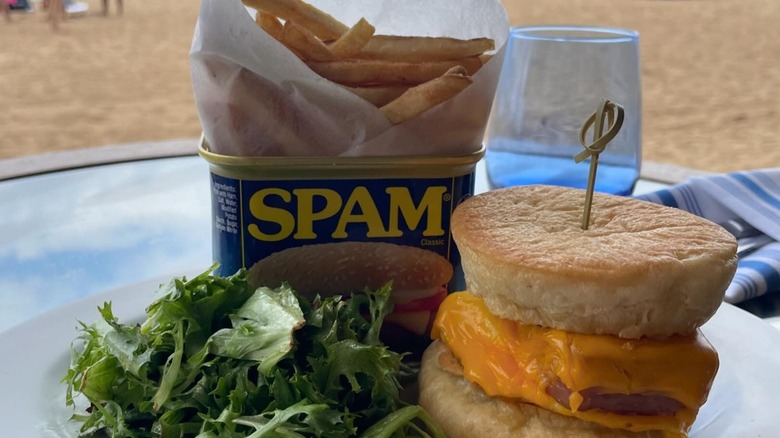There's A Reason Spam Is So Beloved In Hawaii
Since Hormel Foods introduced Spam in 1937, the canned meat has taken on a life of its own. It comes in 11 flavor varieties, and people eat 12.8 cans every second across 50 countries, according to Hormel Foods. In the United States, though, Hawaiians are responsible for consuming 7 million cans each year, says the brand — the most per capita.
The state's love for the product started in 1941, when World War II troops around the world received over 100 million pounds of Spam. At the time, Pearl Harbor was a crucial U.S. naval base that received food imports from the mainland. But, there was a major concern that food shipments wouldn't make it to the island, so residents would stockpile cases of the meat product and drive up demand. Spam is shelf-stable, lasting up to five years after its manufactured date, so it's one of the best canned meats to buy and stash away — it's even a chef-approved canned food.
After the war, Spam was largely adopted into the state's culture. Islanders typically fry and eat it with rice but have begun getting creative with the meat in other local dishes. Some have even started making their own versions of Spam from scratch.
Spam musubi, loco moco, and other Hawaiian dishes
One of those Hawaiian-specific dishes is Spam musubi. Over time, it has become a staple. Musubi usually features caramelized Spam, placed on a similar-sized bed of rice, and then wrapped with a piece of dried seaweed (kind of like sushi). Its origins are disputed but widely credited to Japanese-American entrepreneur and nutritionist Barbara Funamura. Taking her son's advice, the first one she made looked like a triangle, and its current shape evolved from making the snack in a box for uniformity.
For a traditional breakfast, island residents enjoy Spam loco moco. The dish features (from bottom to top) rice, two slices of Spam, gravy, and one over-easy egg. Sometimes, it's garnished with green onion, parsley, and tomato. Because of loco moco's rich flavor and hearty nature, it can be enjoyed for lunch and dinner, too.
The many other ways that Hawaiians use Spam in their diets reflect the unmatched love and demand for the product in the state. Residents use it for kabobs, stir-fries, sandwiches, pizzas, bread puddings, and even as a substitute for beef patties on burgers. When making any of these dishes at home, you can use the Spam lid to cut the meat into slices and use a knife hack to pry Spam out of the can so it removes easily.
How Spam is still celebrated in Hawaii
Proof of Hawaii's love for Spam isn't just in the numbers; it's in the annual celebrations, too. The musubi dish, for example, is so popular that the restaurant L&L Hawaiian Barbecue established August 8 as National Spam Musubi Day. On the day of honor, the restaurant offers exclusive deals and fun activities, including free musubi and the chance to win prizes; some live events are even held at locations outside of Hawaii.
Another cultural tradition is Waikiki Spam Jam in April and May. It's one of the biggest annual food festivals in the state — attracting tens of thousands of people — and participating restaurants get creative with Spam in a multitude of ways for about two weeks. For instance, attendees can get Spam on Hawaiian burgers, kimchi fried rice, Hawaiian pizza, quesadillas, gyros, and even ramen. The main event, though, is a block party with live entertainment and a variety of vendors that sell locally-crafted goods and retail products. Additionally, the festival acts as a fundraiser that gives back to local communities.
Beyond specific events, several restaurants in Hawaii feature Spam dishes on their daily menus. McDonald's has a Spam, rice, and egg breakfast, while Zippy's adds Spam to its Surf Pac and Zip Pac plates and its breakfast bento and offers Spam musubi catering platters.



